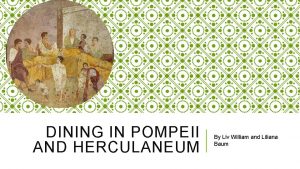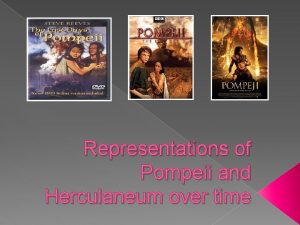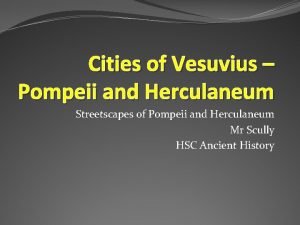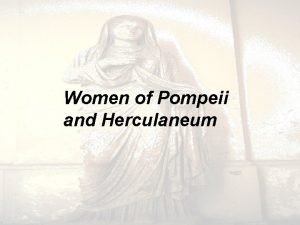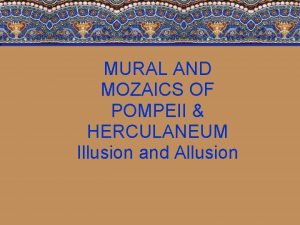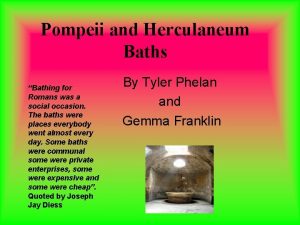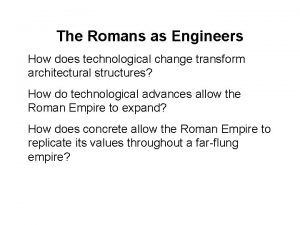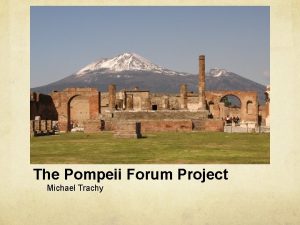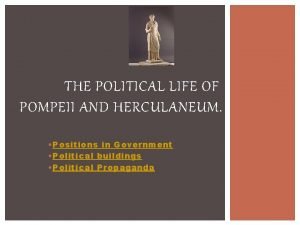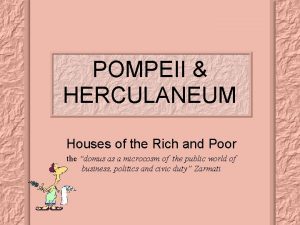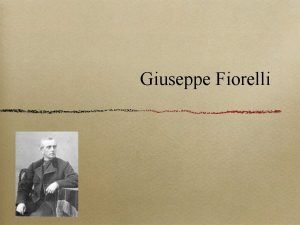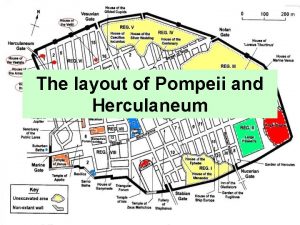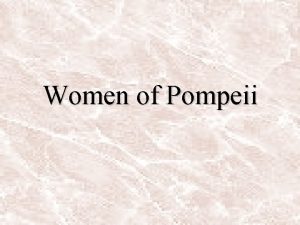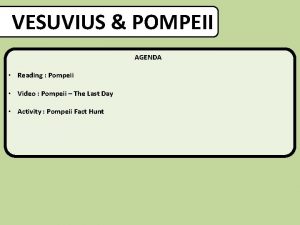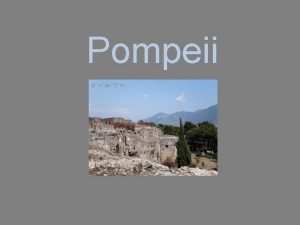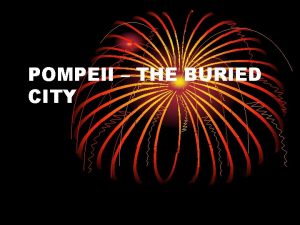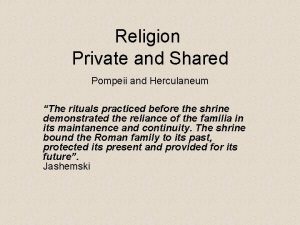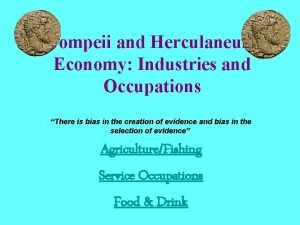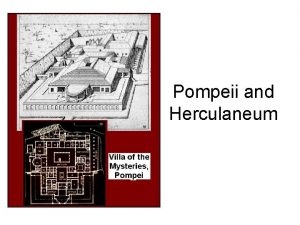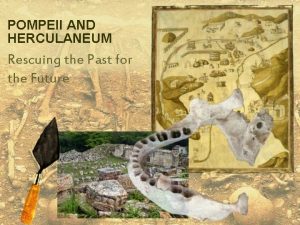THE POLITICAL LIFE OF POMPEII AND HERCULANEUM Positions













- Slides: 13

THE POLITICAL LIFE OF POMPEII AND HERCULANEUM. • Positions in Government • Political buildings • Political Propaganda

STATUE DEPICTING MARCUS NONIUS BALBUS Marcus Nonius Balbus was a prominent figure in the Augustan period. The statue, located on the terrace at the entrance of the Suburban Baths, has been rebuilt recomposing the head and the base, found 65 years ago by Amedeo Maiuri, with the body found, 40 years after, during the excavations on the ancient beach. He was a key leader in the town of Herculaneum and a very influential local patron.

EUMACHIA At Pompeii, the corporation of fullers erected a statue in honour of the public priestess Eumachia who provided, at her own expense, a new building to the forum in her own name and in that of her son. She reveals the role of women in the political society and as they weren’t allowed to participate in the magistrates they were allowed to hold religious authority roles.

POLITICAL BUILDINGS Politics was a major aspect of Pompeii and this can be seen in the large presence and dedication that went towards buildings of the political use. Firstly this is evident due to the large area they take up in the forum. Then also the huge work gone into the architecture and scope of the three buildings; basilica, curia and comitium. Therefore the importance of political life to the ancient society of Pompeii was very great. The basilica was the place of law court, the comitium was the voting place and the Curia is suggested to be the seating place for the town magistrates to commence their business.

COMITIUM The Comitium, in the corner between the Forum and Via dell'Abbondanza, served as a polling station where the electorate (men only) would go during elections with their tesserula, a sort of polling card attesting to the voter's identity. On the southern side of the building we find a podium where the magistrates sat when presiding over the electoral proceedings, while the other two walls contained niches housing honorary statues.

BASILICA The Basilica was the oldest and most important public building in Pompeii. In the beginning, it was a covered market, a meeting place; however, during the earthquake of A. D. 62 the roof fell in. It then became an openair market and finally the seat of the judicial system. It served the administration of justice, and for meetings of business men to discuss their affairs. The Basilica was one of the busiest places in Pompeii.

THE FORUM The forum was the central meeting place for the general public (publica) of Pompeii. It acted as a town centre therefore it held the major buildings of the city. This included social, political and cultural areas. This can be seen in the reconstruction of the Pompeii forum where we see the segregated areas all surrounding the central part of the forum. The forum in Herculaneum has not been uncovered yet.

CURIA This building is interpreted as the Curia. Its location close to the basilica is in favour of this identification. It is a rectangular hall with an apse in the end wall. In front of this at floor level lies a moulded marble slab which can be seen as the place for the chairman of the assembly. On either side are three rectangular niches, into which are built projecting masonry bases. There is only a greyand-white marble pavement in the middle zone which proves that it was the intention to build a continuous dais along the side walls as seating place for the magistrates of the city.

POLITICAL PROPAGANDA The walls of the houses in Pompeii are frequently covered with inscriptions: these are electoral propaganda messages which urge the citizens to vote for one or other of the candidates. At times an entire category of workers (goldsmiths, marble-cutters, bakers, blacksmiths) holds the candidacy. At other times an aspiring magistrate puts himself forward to the people for a particular office. They are written in red or in black and for the most part in capital letters. There around three thousand electoral inscriptions in Pompeii and most of them can be dated to the city's final year of existence, given that it was customary to rub out the old inscriptions to make way for new ones. Herculaneum's walls contain some graffiti but not to the extent of Pompeii.

A RECONSTRUCTION OF A POMPEII STREET WITH POLITICAL PROPAGANDA Here is an example of how a typical street in Pompeii or Herculaneum would look due to the political propaganda placed on the walls to encourage a voter to vote for a certain person to become Duumviri or aediles. The whole town took a keen interest in the election campaign, as can be seen from the many inscriptions found on the walls.

GRAFFITO This is an actual example of what the Pompeii style graffiti looked like. It tended to be found on house and shop fronts on main streets and grouped around busy intersections. It was a fundamental aspect for the women of the village as it was the only form of communication they had to the public to encourage them to vote in the way they wanted.

FORMULAIC TEXT Electoral notices tend to follow a set pattern and use standard abbreviations that everyone knew. They follow a formula that rarely varies. The candidate was often described as a young man although most of them weren’t young at all and usually describes their kind and honourable nature.

EPITAPH ON TOMB In ancient times the life achievements of a person were often depicted on their tombstones. Most of these consisted of the political roles in which they had held in their society. This is a tomb epitaph where great pride is taken in the roles in which the person has held in their society.
 Food and dining in pompeii and herculaneum
Food and dining in pompeii and herculaneum A day in pompeii vimeo
A day in pompeii vimeo Streetscapes in herculaneum
Streetscapes in herculaneum Pompeii and herculaneum source booklet
Pompeii and herculaneum source booklet Role of women in pompeii
Role of women in pompeii Herculaneum
Herculaneum Herculaneum baths
Herculaneum baths Basilica town
Basilica town Roman concrete
Roman concrete Pompeii forum project
Pompeii forum project Comitium pompeii
Comitium pompeii Poor pompeii houses
Poor pompeii houses Guiseppe fiorelli
Guiseppe fiorelli Hoe onstaat een vulkaan
Hoe onstaat een vulkaan
